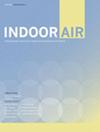植物减少室内二氧化碳与健康效应之间的关系
IF 4.3
2区 环境科学与生态学
Q1 CONSTRUCTION & BUILDING TECHNOLOGY
引用次数: 0
摘要
居民和工人暴露在高二氧化碳水平的建筑物中可能会导致头痛、呼吸困难、疲劳或困倦。然而,植物对建筑内二氧化碳减排和缓解不利影响的作用在很大程度上是未知的。我们招募了36名来自有植物的办公室的健康参与者和32名来自另一间没有植物的办公室的健康参与者。2020年在有植物的办公室的参与者将在2021年搬到没有植物的办公室。每位参与者每年12次重复测量CO2、细颗粒物(PM2.5)、总挥发性有机化合物(TVOCs)、血压(BP)、血清CO2 (TCO2),以及头痛、呼吸困难、疲劳和困倦4个评分问题。通过t检验和配对t检验,统计结果表明,与没有植物的办公室相比,在有植物的办公室工作的参与者的困倦和收缩压水平明显较低。采用混合效应模型,观察室内有植物(1.32%)和无植物(4.52%)办公室室内CO2浓度与血清CO2浓度的相关性。此外,在办公室也观察到室内二氧化碳与嗜睡之间的联系(有植物:14.57%;不含植物:3.82%)。本研究的结论是,办公室环境中的植物可以降低二氧化碳水平,并可能降低二氧化碳对健康的影响。本文章由计算机程序翻译,如有差异,请以英文原文为准。
The Association between Indoor Carbon Dioxide Reduction by Plants and Health Effects
Residents and workers exposure to high carbon dioxide (CO2) levels in buildings may cause headache, dyspnea, fatigue, or drowsiness. However, the effect of plants on in-building CO2 reduction and adverse effect relief is largely unknown. We recruited 36 healthy participants from an office room with plants and 32 healthy participants from another office room without plant in the same office building in Taipei. The participants in the office room with plants during 2020 would move to the office room without plant in 2021. The twelve repeated measurements per year of CO2, fine particles (PM2.5), total volatile organic compounds (TVOCs), blood pressure (BP), serum CO2 (TCO2), and four rating questions of headache, dyspnea, fatigue, and drowsiness were obtained for each participant. The statistical results showed that levels of drowsiness and systolic BP were significantly lower among participants in the office room with plants compared to those in the office room without plants by
t
-test and paired
t
-test. The associations between increased indoor CO2 and increased serum CO2 were observed in the office room with plants (1.32%) and without plant (4.52%) by mixed-effects models. Also, the associations between indoor CO2 and drowsiness were observed in office rooms (with plants: 14.57%; without plant: 3.82%). The conclusion of the present study is that plants in office environment can reduce CO2 levels and may lower CO2-related health effects.
求助全文
通过发布文献求助,成功后即可免费获取论文全文。
去求助
来源期刊

Indoor air
环境科学-工程:环境
CiteScore
10.80
自引率
10.30%
发文量
175
审稿时长
3 months
期刊介绍:
The quality of the environment within buildings is a topic of major importance for public health.
Indoor Air provides a location for reporting original research results in the broad area defined by the indoor environment of non-industrial buildings. An international journal with multidisciplinary content, Indoor Air publishes papers reflecting the broad categories of interest in this field: health effects; thermal comfort; monitoring and modelling; source characterization; ventilation and other environmental control techniques.
The research results present the basic information to allow designers, building owners, and operators to provide a healthy and comfortable environment for building occupants, as well as giving medical practitioners information on how to deal with illnesses related to the indoor environment.
 求助内容:
求助内容: 应助结果提醒方式:
应助结果提醒方式:


